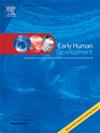Predictors of outcome in patients with cerebral palsy following selective dorsal rhizotomy
IF 2.2
3区 医学
Q2 OBSTETRICS & GYNECOLOGY
引用次数: 0
Abstract
Background
To identify outcome predictors of selective dorsal rhizotomy (SDR) in children with spastic cerebral palsy (CP) using logistic regression models.
Methods
A retrospective single-center study was conducted on children with spastic CP who had undergone SDR. Two outcomes were defined, one representing children not improving in motor function and spasticity and one representing children improving in motor function two years after surgery. Baseline variables were chosen based on established regressors and clinical considerations and tested for being predictors using multivariate logistic regression.
Results
We included 96 patients (mean age [SD] 6y 9 m [2y 5 m], range 2y to 17y) in the study. Significant predictors of non-improvement in motor function and spasticity two years after SDR were higher age at surgery and higher preoperative Gross Motor Function Measure-88 (GMFM-88) score. Significant predictors of motor function improvement after SDR were lower preoperative Modified Ashworth Scale (MAS) scores, higher preoperative passive range of motion (pROM) and lower age at surgery.
Conclusions
For the first time, pROM and preoperative spasticity were identified as predictors of SDR outcome. We confirmed motor function and age as predictors. These variables will be useful for future patient selection. Adjusting for the GMFM-88's ceiling effect, children with higher motor function can still profit significantly from SDR.
选择性背神经根切断术后脑瘫患者预后的预测因素
背景:利用logistic回归模型确定痉挛性脑瘫(CP)患儿选择性背根切断术(SDR)的预后预测因素。方法采用回顾性单中心研究方法对痉挛性脑瘫患儿行SDR治疗。定义了两种结果,一种代表儿童的运动功能和痉挛没有改善,另一种代表儿童的运动功能在手术后两年有所改善。根据已建立的回归因子和临床考虑因素选择基线变量,并使用多变量逻辑回归测试作为预测因子。结果纳入96例患者,平均年龄[SD] 6y 9 m [2y 5 m],年龄范围为2y ~ 17y。SDR后两年运动功能和痉挛无改善的重要预测因素是手术年龄较高和术前大运动功能测量-88 (GMFM-88)评分较高。术前改良Ashworth量表(MAS)评分较低、术前被动活动度(pROM)较高和手术年龄较低是SDR术后运动功能改善的重要预测因素。结论首次发现胎膜早破和术前痉挛是SDR预后的预测因素。我们确认运动功能和年龄是预测因子。这些变量将有助于未来的患者选择。调整GMFM-88的上限效应后,运动功能较高的儿童仍然可以从SDR中获得显著收益。
本文章由计算机程序翻译,如有差异,请以英文原文为准。
求助全文
约1分钟内获得全文
求助全文
来源期刊

Early human development
医学-妇产科学
CiteScore
4.40
自引率
4.00%
发文量
100
审稿时长
46 days
期刊介绍:
Established as an authoritative, highly cited voice on early human development, Early Human Development provides a unique opportunity for researchers and clinicians to bridge the communication gap between disciplines. Creating a forum for the productive exchange of ideas concerning early human growth and development, the journal publishes original research and clinical papers with particular emphasis on the continuum between fetal life and the perinatal period; aspects of postnatal growth influenced by early events; and the safeguarding of the quality of human survival.
The first comprehensive and interdisciplinary journal in this area of growing importance, Early Human Development offers pertinent contributions to the following subject areas:
Fetology; perinatology; pediatrics; growth and development; obstetrics; reproduction and fertility; epidemiology; behavioural sciences; nutrition and metabolism; teratology; neurology; brain biology; developmental psychology and screening.
 求助内容:
求助内容: 应助结果提醒方式:
应助结果提醒方式:


